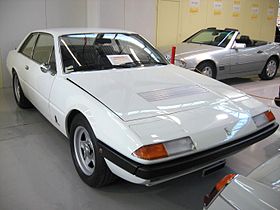Ferrari 412
| Ferrari 365 GT4 2+2/400/412 | |
|---|---|

Ferrari 365 GT4 2+2
|
|
| Overview | |
| Manufacturer | Ferrari |
| Production | 1972–1989 2907 produced in total |
| Designer | Leonardo Fioravanti at Pininfarina |
| Body and chassis | |
| Class | Grand tourer (S) |
| Layout | Front-engine, rear-wheel-drive |
| Related | Ferrari 365 GTB/4 |
| Chronology | |
| Predecessor | Ferrari 365 GTC/4 |
| Successor | Ferrari 456 |
| Ferrari 365 GT4 2+2 | |
|---|---|
 |
|
| Overview | |
| Production | 1972–1976 524 produced |
| Powertrain | |
| Engine | 4.4 L F 101 AC V12 |
| Transmission | 5-speed manual |
| Dimensions | |
| Wheelbase | 2,700 mm (106.3 in) |
| Length | 4,810 mm (189.4 in) |
| Width | 1,796 mm (70.7 in) |
| Height | 1,310 mm (51.6 in) |
| Curb weight | 1,500 kg (3,307 lb) (empty) |
| Ferrari 400 Automatic Ferrari 400 GT |
|
|---|---|

1979 Ferrari 400 GT
|
|
| Overview | |
| Production | 1976–1979 355 (A), 147 (GT) produced |
| Powertrain | |
| Engine | 4.8 L F 101 C V12 |
| Transmission | 5-speed manual 3-speed automatic |
| Dimensions | |
| Wheelbase | 2,700 mm (106.3 in) |
| Length | 4,810 mm (189 in) |
| Width | 1,796 mm (70.7 in) |
| Height | 1,310 mm (51.6 in) |
| Curb weight | 1,700 kg (3,748 lb) (empty) |
| Ferrari 400 GT i Ferrari 400 Automatic i |
|
|---|---|

"Series II" 400 GT i
|
|
| Overview | |
| Production | 1979–1985 422 (GT) & 883 (A) produced |
| Powertrain | |
| Engine | 4.8 L F 101 D V12 |
| Transmission | 5-speed manual 3-speed automatic |
| Dimensions | |
| Wheelbase | 2,700 mm (106.3 in) |
| Length | 4,810 mm (189 in) |
| Width | 1,798 mm (70.8 in) |
| Height | 1,314 mm (51.7 in) |
| Curb weight | 1,830 kg (4,034 lb) (empty) |
| Ferrari 412 | |
|---|---|
 |
|
| Overview | |
| Production | 1985–1989 270 (GT) and 306 (A) produced |
| Powertrain | |
| Engine | 4.9 L F 101 EL V12 |
| Transmission | 5-speed manual 3-speed automatic |
| Dimensions | |
| Wheelbase | 2,700 mm (106.3 in) |
| Length | 4,810 mm (189 in) |
| Width | 1,798 mm (70.8 in) |
| Height | 1,314 mm (51.7 in) |
| Curb weight | 1,805–1,810 kg (3,979–3,990 lb) |
The Ferrari 365 GT4 2+2, Ferrari 400 and Ferrari 412 (Tipo F101) are front-engined V12 2+2 grand tourers made by Italian manufacturer Ferrari between 1972 and 1989. The three cars are closely related, using the same body, chassis and engine evolved over time.
Following Ferrari practice, their numeric designations refer to their engines' single-cylinder displacement expressed in cubic centimetres. The 365 GT4 2+2 was introduced in 1972 to replace the 365 GTC/4. It then evolved into the 400, the first Ferrari available with an automatic transmission. In 1979 the 400 was replaced by the fuel injected 400 i. The improved 412 ran from 1985 to 1989, bringing to an end Ferrari's longest-ever production series.
Although the option of an automatic transmission and compliance with U.S. emissions indicate it may have been designed for the American market, no version of these grand tourers was ever officially imported there. Many, however, entered as grey imports.
Ferrari turned to frequent styling partner Leonardo Fioravanti at Pininfarina, whose three-box design for the 365 GT4 2+2 was a clear departure from its fastback predecessor, the 365 GTC/4. It followed Fioravanti's Ferrari 365 GTB/4 Daytona as the second Ferrari to feature the characteristic swage line dividing the body into upper and lower halves.
Various coachbuilders, such as Carrozzeria Pavesi and Straman, offered convertible conversions of the 400 series. Switzerland's Felber also showed a shooting brake version on 400 GT basis called the Felber Croisette at the 1981 Geneva Salon de l'Auto.
...
Wikipedia
